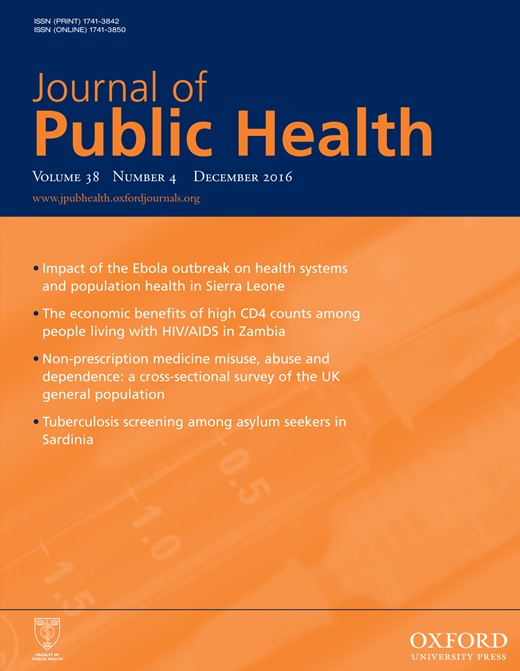-
PDF
- Split View
-
Views
-
Cite
Cite
Eugene Milne, What is public health?, Journal of Public Health, Volume 38, Issue 4, December 2016, Pages 633–634, https://doi.org/10.1093/pubmed/fdw137
Close - Share Icon Share
Earlier this year when the NHS decided, on the basis of advice considered by many at the time to be suspect, that it was precluded by law from prescribing PrEP the decision was unsurprisingly greeted with outrage and rapid legal challenge.1
At the beginning of August 2016, judicial review of the NHS decision ruled there was no legal bar to NHS funding of the medicine.2 And on 10 November, the Court of Appeal upheld that decision.3
The NHS emerges from this episode badly. It looks either to have been poorly advised, or to have sought in its advice an answer it was keen to find at a time of financial stress. Disputes of this kind should not need to end up, at much public expense, in courts of law—a point clearly made in the ruling. And there is a measure of reputational damage that we would not wish to see. Accusations of discrimination have accompanied the row.
But the Appeal Court ruling was not quite the resolution one might have hoped for.
The appeal court judges did not doubt that the intention of parliament in passing the Health and Social Care Act was to exempt the NHS from public health functions, which would instead be the responsibility of Local Authorities and the Secretary of State.
More alarmingly, the third of the appeal court judges, Lady Justice King, considered that NHSE could ’only’ provide PrEP on the basis that its provision is not a public health function.
Awkwardly, however, nobody had ever quite got around to defining exactly what public health is, or what constitutes a public health function.
When the 2012 English Health and Social Care Act split public health away from the National Health Service and placed—perhaps, more properly, returned—it to local authorities, that particular decision proved one of the calmest elements of an otherwise stormy piece of legislation.4 Many of us had been pressing for years for a broadening of public health action to include aspects of economic, cultural and environmental action beyond the reach of health care.5 Local authorities seemed, and continue to seem, a better base from which to achieve that sort of change.
When the split was put into effect, it was based upon a semi-arbitrary definition of expenditures and job descriptions, supported by a logic-defying, if short, list of mandated elements and a rather longer list of preventive aspirations.
Sexual health services transferred, but HIV treatment did not. So both sides provide related treatment options. Neither side has a monopoly on prevention—and the judges ruled out a distinction on this basis.
The law itself includes among public health responsibilities the catch-all option of ‘providing other services or facilities for the prevention, diagnosis or treatment of illness’. So the limits of NHS competence could not be defined as ’that which is not public health’ since such a definition would, at an extreme, exempt the NHS from most of its business.
The judges did not solve this conundrum.
As I (a non-lawyer) read it, they settled instead for the view that whatever a ‘public health function’ might be, PrEP is not it; that it is not covered by the exemption; and, being indistinguishable from a treatment, is within the powers of the NHS.
Nationally, the funding that transferred from the NHS with public health constituted only ~4% of the total NHS budget, and most of that is still supporting core services. That has not stopped moaning and accusations from clinicians and others of ‘raiding the public health budget’ as councils have begun to exert local control over the tiny flexible element.6
To some extent the accusations may be true. But with no agreed definition in law or the minds of senior judges, it is not surprising that local political choice offers a plausible, and many would say better, alternative.
It seems unlikely that it was the intention of parliament to move public health from the NHS to local authorities only for local authorities to continue providing the same services as had existed previously in the NHS, or for the NHS to continue dictating the definition of public health.
Since publication of the Five Year Forward View, the NHS has shown worrying signs of trying to reinvent public health to suit its own worldview—as an individualistic, behavioural, lifestyle issue (e.g. in the National Diabetes Prevention Programme).7
Yet, perversely, it has also funded the ‘Healthy New Towns’ initiative, which seeks to take ‘an ambitious look at improving health through the built environment’.8 Notwithstanding the lack of a formal definition, I doubt anyone would argue that the latter is not an out and out public health function, though the NHS may not wish to ask Lady Justice King whether that is ultra vires.
For what it is worth, my own, admittedly imperfect rule of thumb, is that if you can name who benefits, it is probably health or social care, whereas if you know that somebody benefits but you can't say who—and particularly if the recipients are asymptomatic—it is probably public health.
It is a crude definition with woolly edges, but to my mind that just reflects reality.
As an intervention, PrEP looks promising if it is used for the highest risk individuals, if they are highly compliant with the dosage regime, and if the price is sufficiently reasonable. With that level of specificity, it lies closer to the treatment end of the rule-of-thumb scale.
So the court judgement is welcome, despite the questions it leaves unanswered. But, for goodness sake, let's agree to sort this out in future without going to law.



